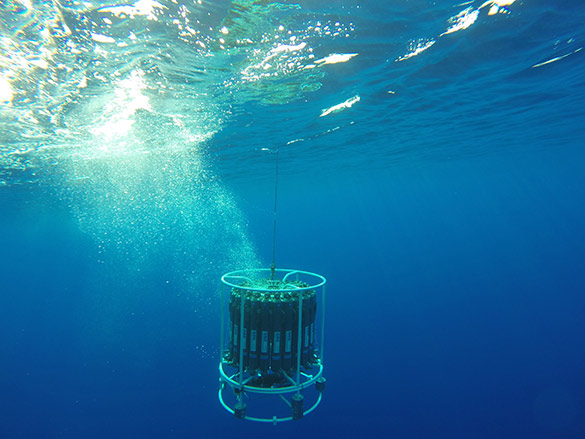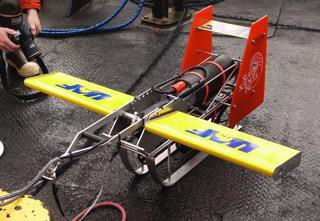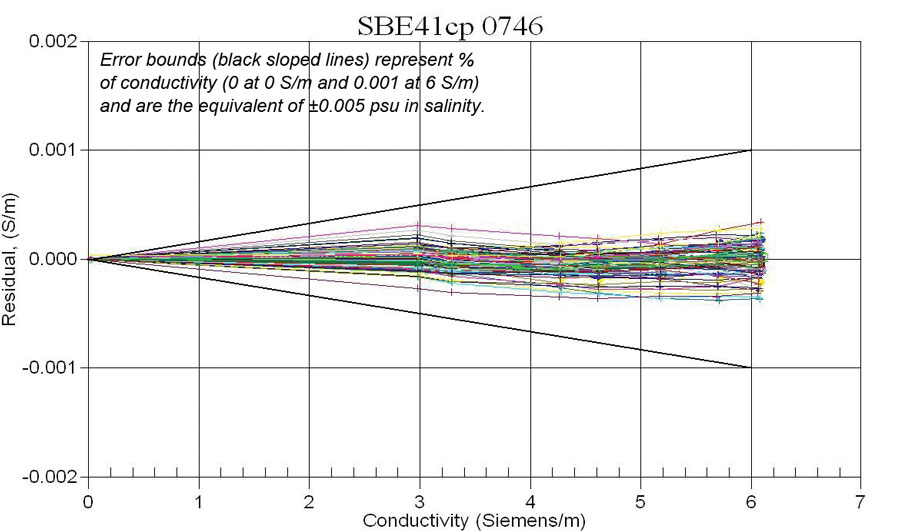- PRODUCTS
- MODEL LIST
- APPLICATIONS
- SUPPORT
- SALES/SERVICE
- BLOG
- ABOUT
Profiling
A Profiling CTD rapidly measures water parameters as it travels through the water. These instruments generate a high-resolution dataset of a vertical column of water, whether they are lowered over the side of a ship or integrated with an autonomous vehicle or glider.
Common to all Sea-Bird Profiling CTDs:
• Purposeful designs built to perform under the unique dynamic conditions found on varying measurement platforms
• Pumped and ducted constant flow for matched temperature and conductivity response
• Measurements are made on the same sample of water with a predictable delay and predictable flow effects
• Aligning and coordinating measurements done with software or (for some models) automatically
Profiling CTDs can be utilized via traditional shipboard deployments, or they can be integrated with an autonomous vehicle like an ROV (Remotely Operated Vehicle), glider, or an Argo float that drifts with the currents. CTDs are not one-size-fits-all instruments; the type of vehicle and characteristics of its use dictates the CTD design that will provide the best data. Because some of these CTDs are deployed for an extended period of time (up to 3 to 5 years on an Argo float), they are subject to fouling – the growth of marine organisms on and inside the sensors. Sea-Bird uses EPA-approved anti-foulant devices to keep the inside of the sensors clean, so that fouling will not affect the measurements.
The SBE 911plus CTD is the primary oceanographic research tool used by the world’s leading institutions, providing 24 samples/second with an SBE 9plus CTD Unit and SBE 11plus V2 Deck Unit. The 911plus system provides real-time data collection over 10,000 meters of cable. The 911plus supports numerous auxiliary sensors (dissolved oxygen, pH, turbidity, fluorescence, oil, PAR, nitrates, altimeter, etc.) with eight A/D channels.
The SBE 19plus V2 SeaCAT measures conductivity, temperature, and pressure at 4 scans/second and provides high accuracy, resolution, and reliability in an integrated package for a wide range of research, monitoring, and engineering applications. The 19plus V2 has fully integrated temperature, conductivity, and pressure sensors, and supports numerous auxiliary sensors (dissolved oxygen, pH, turbidity, fluorescence, oil, PAR, nitrates, altimeter, etc.) with six A/D channels and one RS-232 data channel.
The SBE 25plus Sealogger is an ideal research-quality CTD profiler for coastal, estuarine, and deep-water deployments. The battery-powered 25plus samples at 16 Hz and records data in memory, eliminating the need for a large vessel, electro-mechanical sea cable, and on-board computer, and can also transmit data in real-time.
The Sea-Bird SBE 41/41CP Argo CTD module was developed in response to the scientific need for highly stable and accurate temperature and salinity on profiling floats. The standard CTD for Argo floats, the SBE 41/41CP have helped provide an unprecedented amount of data since the creation of the Argo program. As the global distribution of profiling floats expands and more floats enter the water, Sea-Bird has built upon the capabilities of the 41/41CP. Today, float CTDs can house new and improved sensors with flexible integration options for various float platforms.
The SBE 61 Deep Argo CTD is a redesign of the SBE 41/41CP designed for deployments to 7000 m, with improved overall measurement quality and stability to meet the needs of deep ocean research. Each SBE 61 is chosen from an extended calibration history, ensuring stable electronics and minimal drift in the field. The hardware interface and many commands have been carried over to make integration into existing SBE 41/41CP-based products easier.
Common to all Sea-Bird Profiling CTDs:
• Purposeful designs built to perform under the unique dynamic conditions found on varying measurement platforms
• Pumped and ducted constant flow for matched temperature and conductivity response
• Measurements are made on the same sample of water with a predictable delay and predictable flow effects
• Aligning and coordinating measurements done with software or (for some models) automatically
Profiling CTDs can be utilized via traditional shipboard deployments, or they can be integrated with an autonomous vehicle like an ROV (Remotely Operated Vehicle), glider, or an Argo float that drifts with the currents. CTDs are not one-size-fits-all instruments; the type of vehicle and characteristics of its use dictates the CTD design that will provide the best data. Because some of these CTDs are deployed for an extended period of time (up to 3 to 5 years on an Argo float), they are subject to fouling – the growth of marine organisms on and inside the sensors. Sea-Bird uses EPA-approved anti-foulant devices to keep the inside of the sensors clean, so that fouling will not affect the measurements.
The SBE 911plus CTD is the primary oceanographic research tool used by the world’s leading institutions, providing 24 samples/second with an SBE 9plus CTD Unit and SBE 11plus V2 Deck Unit. The 911plus system provides real-time data collection over 10,000 meters of cable. The 911plus supports numerous auxiliary sensors (dissolved oxygen, pH, turbidity, fluorescence, oil, PAR, nitrates, altimeter, etc.) with eight A/D channels.
The SBE 19plus V2 SeaCAT measures conductivity, temperature, and pressure at 4 scans/second and provides high accuracy, resolution, and reliability in an integrated package for a wide range of research, monitoring, and engineering applications. The 19plus V2 has fully integrated temperature, conductivity, and pressure sensors, and supports numerous auxiliary sensors (dissolved oxygen, pH, turbidity, fluorescence, oil, PAR, nitrates, altimeter, etc.) with six A/D channels and one RS-232 data channel.
The SBE 25plus Sealogger is an ideal research-quality CTD profiler for coastal, estuarine, and deep-water deployments. The battery-powered 25plus samples at 16 Hz and records data in memory, eliminating the need for a large vessel, electro-mechanical sea cable, and on-board computer, and can also transmit data in real-time.
The Sea-Bird SBE 41/41CP Argo CTD module was developed in response to the scientific need for highly stable and accurate temperature and salinity on profiling floats. The standard CTD for Argo floats, the SBE 41/41CP have helped provide an unprecedented amount of data since the creation of the Argo program. As the global distribution of profiling floats expands and more floats enter the water, Sea-Bird has built upon the capabilities of the 41/41CP. Today, float CTDs can house new and improved sensors with flexible integration options for various float platforms.
The SBE 61 Deep Argo CTD is a redesign of the SBE 41/41CP designed for deployments to 7000 m, with improved overall measurement quality and stability to meet the needs of deep ocean research. Each SBE 61 is chosen from an extended calibration history, ensuring stable electronics and minimal drift in the field. The hardware interface and many commands have been carried over to make integration into existing SBE 41/41CP-based products easier.

Profiling CTDs make continuous measurements as they travel through water. When lowered over the side of a ship or integrated with an autonomous vehicle, they map a vertical column of water's characteristics. Compared to moored CTDs, profiling CTDs account for dynamic errors introduced by moving through water and sample rapidly to generate a high-resolution dataset over a short period of time. Sea-Bird Scientific profiling CTDs are:
- Designed to perform under unique dynamic conditions found on moving platforms.
- Pumped and ducted for constant flow to match temperature and conductivity response.
- Plumbed so measurements are made on the same sample of water with a predictable delay and predictable flow effects.
- Built with a rugged design for shipboard and autonomous deployments.
Profiling CTDs can be utilized via traditional shipboard deployments, or they can be integrated with an autonomous vehicle like an ROV (Remotely Operated Vehicle), glider, or an Argo float. Often, they are also integrated was a water sampler, such as the SBE 32 or SBE 55, coordinating CTD data with discrete water samples at depth. Sea-Bird Scientific offers various profiling CTD designs fit for the different vehicles and deployment methods.
Shipboard Applications
The SBE 911plus CTD is the primary oceanographic research tool used by the world’s leading institutions, providing rapid 24 scans/sec sampling and easy integration with water samplers and several auxiliary sensors such as dissolved oxygen and optical sensors. The 911plus system provides real-time data collection over 10,000 meters of cable.
Learn more about the SBE 911plus CTD
Learn more about the SBE 911plus CTD
The SBE 19plus V2 SeaCAT measures at 4 scans/sec and provides high accuracy and resolution, reliability, and ease-of-use for a wide range of research, monitoring, and engineering applications. Draw power from internal batteries to record data in memory or transmit real-time data over 10,000 meters of cable. Deploy as a shipboard or hand-hauled profiling CTD, or configure as an autonomous moored CTD for in-situ water quality monitoring.
Learn more about the SBE 19plus V2 SeaCAT
Learn more about the SBE 19plus V2 SeaCAT
The 25plus provides eight A/D channels and two RS-232 data channels for wide support of auxiliary sensors, with ample power to act as a truly capable multiparameter sensor package. Operate with batteries for up to 55 hours of profiling or transmit in real-time while simultaneously saving high-resolution 16 scans/sec data in 2 gb of memory.
Learn more about the SBE 25plus Sealogger
Learn more about the SBE 25plus Sealogger
Gliders / AUVs / ROVs
The SBE 49 FastCAT is an integrated CTD sensor intended for use as a modular component in towed vehicles, ROVs, AUVs, or other autonomous platforms that can supply DC power and acquire serial data. It is an easy-to-use, light, and compact instrument, well suited to even the smallest vehicle.
Learn more about the SBE 49 FastCAT
Learn more about the SBE 49 FastCAT
The GPCTD is a modular, low-power profiling instrument for autonomous gliders with the high accuracy necessary for research, inter-comparison with moored observatory sensors, updating circulation models, and leveraging data collection opportunities from operational vehicle missions. The externally powered, continuously pumped CTD consumes only 175 mW recording at 1 scan/second. One Alkaline D cell could operate the CTD continuously for 114 hours (9.5 days at 50% duty cycle, profiling continuously at 1 Hz on every glider upcast); one Lithium DD cell could provide 48 days continuous profiling on every upcast.
Learn more about the Glider Payload CTD
Learn more about the Glider Payload CTD
Profiling Floats
The Sea-Bird SBE 41/41CP Argo CTD module was developed in response to the scientific need for highly stable and accurate temperature and salinity on profiling floats. The standard CTD for Argo floats, the SBE 41/41CP have helped provide an unprecedented amount of data since the creation of the Argo program.
Learn more about the SBE 41/41CP Argo CTD
Learn more about the SBE 41/41CP Argo CTD
The SBE 61 Deep Argo CTD is a redesign of the SBE 41/41CP designed for deployments to 7000 m, with improved overall measurement quality and stability to meet the needs of deep ocean research. Each SBE 61 is chosen from an extended calibration history, ensuring stable electronics and minimal drift in the field. The hardware interface and many commands have been carried over to make integration into existing SBE 41/41CP-based products easier.
Learn more about the SBE 61 Deep Argo CTD
Learn more about the SBE 61 Deep Argo CTD
Case Studies
High-Resolution Biophysical Observations in an Underway Sampling Application

Biophysical processes in the upper ocean are complex. Disentangling the myriad of factors that affects them requires measurements of multiple biological and physical properties across a wide range of temporal and spatial scales. Here we present data from a study by Martini et al. [2016] that uses a suite of sensors to determine the physical controls on subsurface phytoplankton concentrations in the Chukchi Sea.
Read More
Read More
Biophysical processes in the upper ocean are complex. Disentangling the myriad of factors that affects them requires measurements of multiple biological and physical properties across a wide range of temporal and spatial scales. Here we present data from a study by Martini et al. [2016] that uses a suite of sensors to determine the physical controls on subsurface phytoplankton concentrations in the Chukchi Sea.
Read More
Accuracy and Stability of Argo SBE 41 and SBE 41CP CTD Conductivity and Temperature Sensors

Two Argo CTDs, an SBE 41 and 41 continuous profiler (cp), were routinely calibrated over 5+ years in the Sea-Bird Alace float facility. Results indicate a very stable calibration system and low drift performance of the SBE 41 and 41cp designs.
Read More
Read More
Two Argo CTDs, an SBE 41 and 41continuous profiler (cp), were routinely calibrated over 5+ years in the Sea-Bird Alace float facility. Results indicate a very stable calibration system and low drift performance of the SBE 41 and 41cp designs.
Read More
x
I Want to Learn More
| 911plus | 19plusV2 | 25plus | 49 | |
|---|---|---|---|---|
| Communication | DPSK RS-232 |
RS-232 | RS-232 USB |
RS-232 |
| Auxiliary Sensors | 8 Analog Sensors 1 Serial Sensor (with modification) 2 Temperature Sensors 2 Conductivity Sensors |
6 Analog Sensors 1 Serial Sensor |
8 Analog Sensors 2 Serial Sensors |
N/A |
| Sampling Speed | 24 Hz | Strain-gauge sensor: 4 Hz Quartz sensor: 2 Hz |
16 Hz | 16 Hz |
| Memory | N/A | 64 Mbyte non-volatile FLASH memory | 2 GByte (Holds approximately 1320 hours of data) | N/A |
| T Range (°C) | -5 to +35 | -5 to +35 | -5 to +35 | -5 to +35 |
| T Accuracy (°C) | ± 0.001 | ± 0.005 | ± 0.001 | ± 0.002 |
| T Resolution (°C) | 0.0002 | 0.0001 | 0.0002 | 0.0001 |
| T Stability (°C) | 0.0002/month | 0.0002/month | 0.0002/month | 0.0002/month |
| C Range (S/m) | 0 to 7 | 0 to 9 | 0 to 7 | 0 to 9 |
| C Accuracy (S/m) | ± 0.0003 | ± 0.0005 | ± 0.0003 | ± 0.0003 |
| C Resolution (S/m) | 0.00004 | 0.00005 (oceanic waters; resolves 0.4 ppm in salinity) 0.00007 (high salinity waters; resolves 0.4 ppm in salinity) 0.00001 (fresh waters; resolves 0.1 ppm in salinity) |
0.00004 | 0.00005 (oceanic waters; resolves 0.4 ppm in salinity) 0.00007 (high salinity waters; resolves 0.4 ppm in salinity) 0.00001 (fresh waters; resolves 0.1 ppm in salinity) |
| C Stability (S/m) | 0.0003/month | 0.0003/month | 0.0003/month | 0.0003/month |
| P Range | 0-10500 meters (multiple depth options available) | 0-10500 meters (multiple depth options available) | 0-7000 meters (multiple depth options available) | 0-10500 meters (multiple depth options available) |
| P Accuracy | ± 0.015% of full scale range | Strain-gauge sensor: ± 0.1% of full scale range Quartz sensor: ± 0.02% of full scale range |
± 0.1% of full scale range | ± 0.1% of full scale range |
| P Resolution | 0.001% of full scale range | Strain-gauge sensor: 0.002% of full scale range Quartz sensor: 0.0025% of full scale range |
0.002% of full scale range | 0.002% of full scale range |
| P Stability | 0.02% of full scale range/year | Strain-gauge sensor: 0.1% of full scale range/year Quartz sensor: 0.02% of full scale range/year |
0.05% of full scale range per year | 0.05% of full scale range per year |
| Weight in air | 29 kg (65 lbs) | 13.7 kg (30 lbs) | Aluminum: 22.5 kg (50 lbs) | 2.7 kg (6 lbs) |
| Weight in water | 20 kg (45 lbs) | 8.6 kg (19 lbs) | Aluminum: 13.5 kg (30 lbs) | 1.4 kg (3 lbs) |
| Plastic Weight in air | Aluminum: 25 kg (55 lbs) | 7.3 kg (16 lbs) | 20.0 kg (44 lbs | 1.8 kg (4 lbs) |
| Plastic Weight in water | Aluminum: 16 kg (35 lbs) | 2.3 kg (5 lbs) | 11.5 kg (25 lbs) | 0.5 kg (1 lb) |
| Power | Shipboard | Shipboard Internal Batteries |
Shipboard Internal Batteries |
From ship/AUV |
| Maximum Depth | 10,500 meters | 10,500 meters | 6,800 meters | 10,500 meters |




